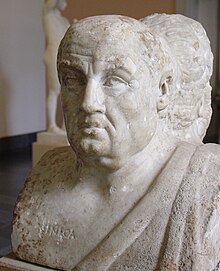This article needs additional citations for verification. (July 2008) |

Senecan tragedy refers to a set of ten ancient Roman tragedies,[1] eight of which were probably written by the Stoic philosopher and politician Lucius Annaeus Seneca.[2] Senecan tragedy, much like any particular type of tragedy, had specific characteristics to help classify it. The three characteristics of Senecan tragedy were: five separate acts, each with a Chorus; recounting of ‘horrors’ and violent acts, which are usually done off-stage; and some sort of parallel of the violence that occurred.[3] Only the Phoenissae departs from the five act structure.[4] In the English literary canon, Seneca appears as a major influence on later texts about revenge, such as Titus Andronicus and The Crying of Lot 49.
- ^ "Senecan tragedy | Roman, Stoic & Tragic | Britannica". www.britannica.com. Retrieved 2024-05-24.
- ^ Ker, James (2010-08-05). "Review of Seneca and the Idea of Tragedy". Notre Dame Philosophical Reviews. ISSN 1538-1617.
- ^ "Senecan tragedy". Oxford Reference.
- ^ Tarrant, R. J. (1978). "Senecan Drama and Its Antecedents". Harvard Studies in Classical Philology. 82: 213–263. doi:10.2307/311033. JSTOR 311033.
© MMXXIII Rich X Search. We shall prevail. All rights reserved. Rich X Search
